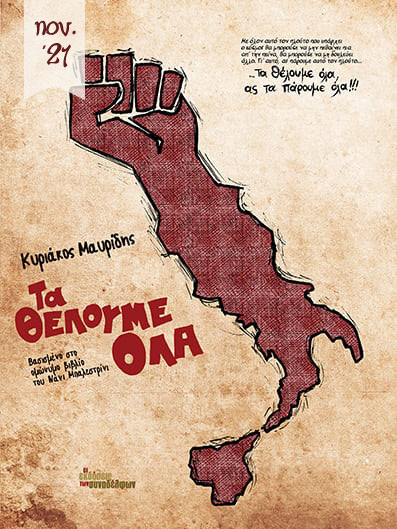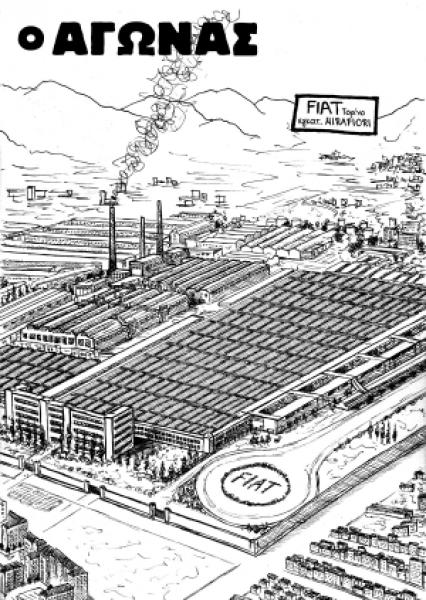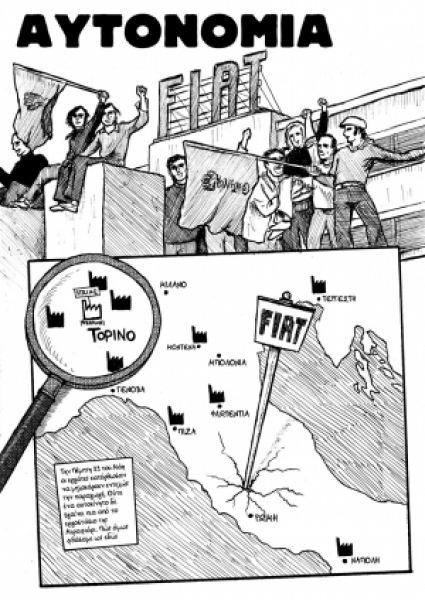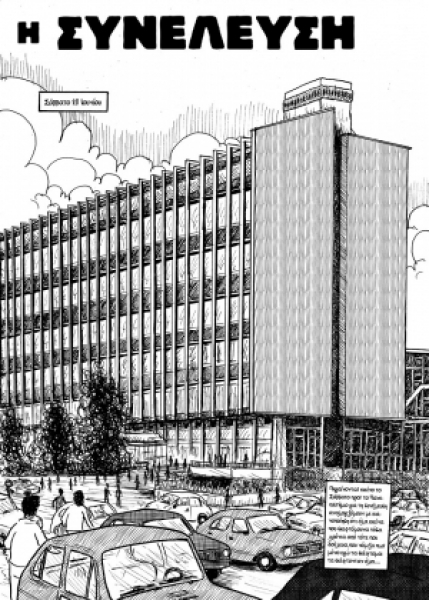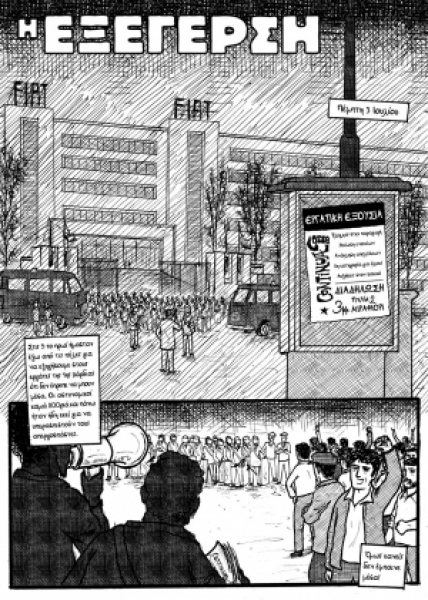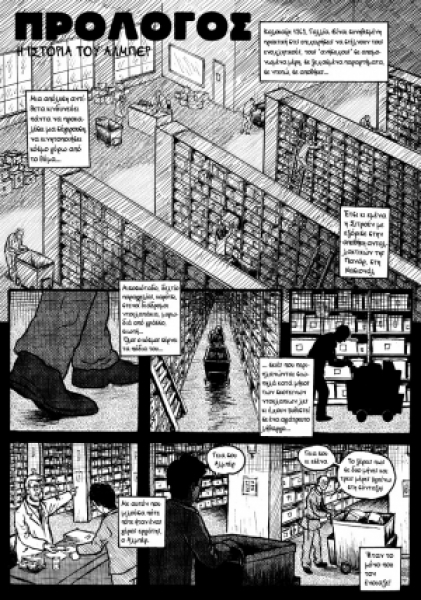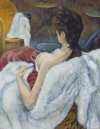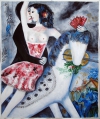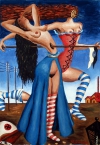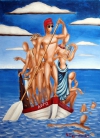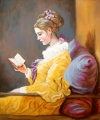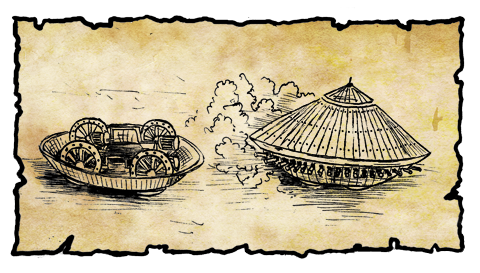
"My Lord,
you ask for my sketches as a friend
but you will use them
as a King"
from my new comic "Leonardo: The dream and the Nightmare" (temporary title)
Displaying items by tag: acrylics
This is a copy of the painting The Model Resting by Henri de Toulouse Lautrec (you can see more here).
I used acrylics which are quite close (at least in terms of speed of working) to temperas (the medium used in the original painting). I tried to keep some of the spontaneous character of the image with the use of individual strokes.
(private collection)
Three new copies of paintings by Vincent van Gogh. The first copy is of the painting Starry Night (info: https://en.wikipedia.org/wiki/The_Starry_Night) and is made with acrylics on paper (50 x 70 cm). The second one is a reproduction of one of the Sunflowers paintings (Still Life - Vase with Twelve Sunflowers) and is made with watercolor pastels on paper (app. 30 x 40 cm). The last one is also made with watercolor pastels (app. 30 x 40 cm) and is a copy of the painting Cafe Terrace at Night.
(private collection)
Another copy of a work by Nikos Eggonopoulos, with the name "Civil War".
(Unfortunately the copy I saw and made my reproduction was cut through the edges -so this is the case for my work too).
If you want to find out more about the painter and poet N. Eggonopoulos you can visit the site :http://www.engonopoulos.gr/_homeEN/
It is a reproduction of a painting by Nikos Engonopoulos. Its name is Argo.
There are not many changes with the original work -perhaps the most notable one is the change of the second word on the boat (I replaced Argo (which is the name of the boat) with the word Σπεύδω (spevdo -which literally means I'm hurrying up -the opposite of the literal meaning of the word Argo -which is "I am delaying").
If you want to find out more about the painter and poet N. Engonopoulos you can visit the site: http://www.engonopoulos.gr/_homeEN/
Copies of works that appear on the film The Mystery of Picasso.
All works belong to private collection.
About the movie: Music by Georges Auric, who also scored Cocteau’s movies. Shot by Claude Renoir, who also shot a handful of his uncle Jean’s films and also Barbarella. Director Clouzot made this between a mystery thriller and a spy parody.
A nice companion movie to La Belle noiseuse, another one where we actually watch a painting being created in real time. The movie introduces Picasso, then cuts to a full shot of a transparent canvas, Picasso’s brush (or pen, whatever) on one side, the camera on the other, so there are a few over-the-shoulder shots but mostly we’re seeing (a mirror image of) the canvas with the painting magically appearing upon it. There are edits and time-lapse too – areas of wet paint dry in an instant, whole areas of color or pattern suddenly appear. Sometimes we’re clearly watching a painting from start to finish in real time, and sometimes they’ll tell us in voiceover how long it actually took.
There’s no narration – rather what little verbal information we learn is in the form of (obviously staged) conversations between artist and camera crew. My favorite bit is when Picasso asks for a very large canvas and suddenly the movie goes into Cinemascope ratio (‘scope was less than three years old, so still a cool novelty).
It’s a suspense/art film as you watch the work in progress and try to wonder what PP is planning, where the painting is heading (even he doesn’t seem to know half the time), and when it’s “done”. The wonder of this film is that the paintings exist through time – most of them look great when complete, but the process and intermediate steps are just as great… you’re not just waiting for good art to appear at an unknown end point, you’re watching it all along. The filmmakers keep it short (<80 minutes), the music styles vary greatly between paintings, and there are some bursts of crew participation, like the time they pressure PP to finish a painting before their reel of film runs out.
(Info by http://deeperintomovies.net/)
Two copies of the painting Young Girl Reading, c.1770 by Jean-Honoré Fragonard (info by http://www.nga.gov/collection/gallery/gg55/gg55-46303.html). Both of them were made with acrylics, on on paper (the first one) and the other on canvas (the second one -which also has a more loose technique).
Both copies belong to private collections.
These are two appropriation paintings based on compositions by Piet Mondrian and three famous paintings from Francisco Goya: Saturn devouring his son (I have "used" this painting again in one of my political sketches), Colossus and the 3rd of May.
I was reluctant at first to make (and publish) these works due to the twisting of the ideas of Mondrian (I used green instead of the primary yellow and of course there are the faded paintings of Goya over the colors). To give an explanation for the green color I was inspired by the colors of the palestinian flag.
For the first painting (not so much for the second version) I was inspired by the resemblance of the black lines with a cage. I wanted to use three paintings -two with similar meaning (oppression, tyrany, giants against people, etc) and on the other hand, on the red color, a painting symbolizing resistance. I enjoyed the idea of a modern (art) cage for old traditional artworks and the implications of such a combination.
Three copies of the painting Tree of Life, by Gustav Klimt (http://www.oil-painting-shop.com). The changes between them are mostly in colors and the general hue of the image.
All works belong to private collections (friends).
This is one of my favourite appropriation works. It combines many of the themes that interested me in painting (appropriation, (pseydo)cubistic landscape, mannequin figures).
The work behind it belongs to Caravaggio and is called The Entombment of Christ (1602–1603). After watching a photograph of Che Guevara a few moments after being murdered, I was amazed by the great resemblance of his face and the face of Christ in Caravaggio's painting. That was the starting point. The second inspiration was my journey in Cuba, the spring of 2008. Afterwards, my ideas cleared a lot about the general meaning I was hoping to achieve and it was inevitable to carry on with the painting.
Apart from the face of Che I changed the whole upper segment of the painting (the group of people holding him and their background). I gave military clothes to the two persons holding Che (one of them reminds Fidel) and behind them I used mannequins with a shift from a Picasso-like face to a oval face like the ones Dali used to create and then another transformation to more cubical forms to match with the geometrical dismantling background of Cuba on top. I added a spanish ship (like the one Colombus used when he discovered Cuba) approaching the island and the Monument of Revolution with the statue of Martin X ready to confront it.
Now in Bookstores
We Want Everything
the publications of colleagues, Nov. 2021
Summer of 1969, Italy. A year after May '68, FIAT workers began a dynamic and unmediated strike against their powerful boss. Their struggle marked the beginning of a decade of workers' and students' mobilizations and the rise of the Autonomy movement. It was characterized by many as the last invasion of the working class into the sky. Last ... let's hope until the next one ...
